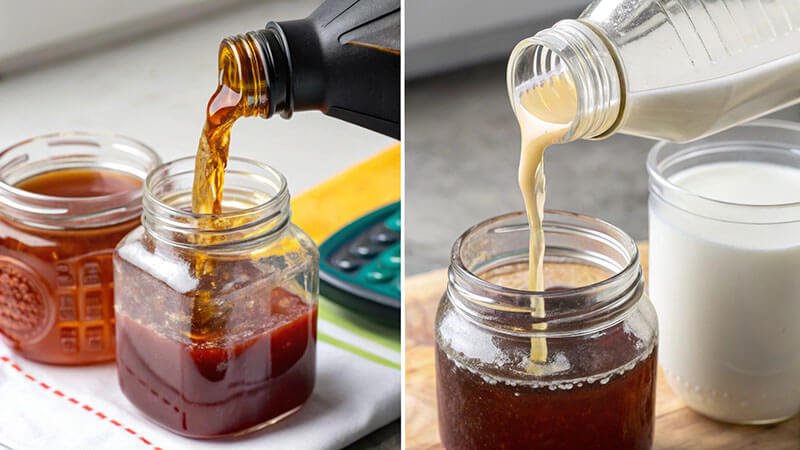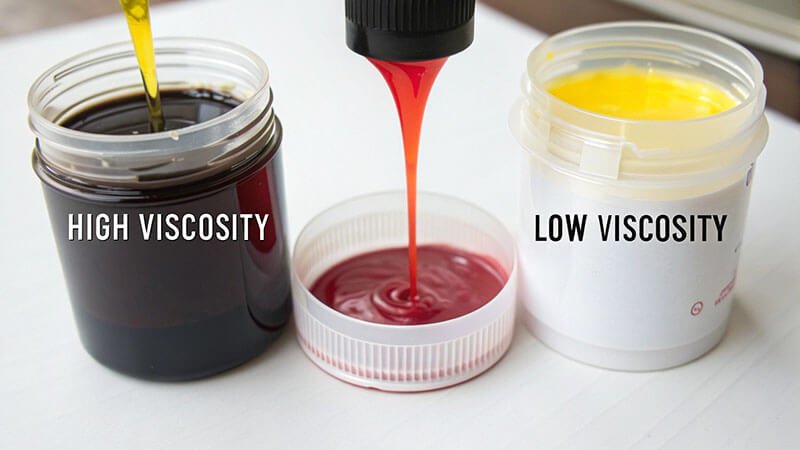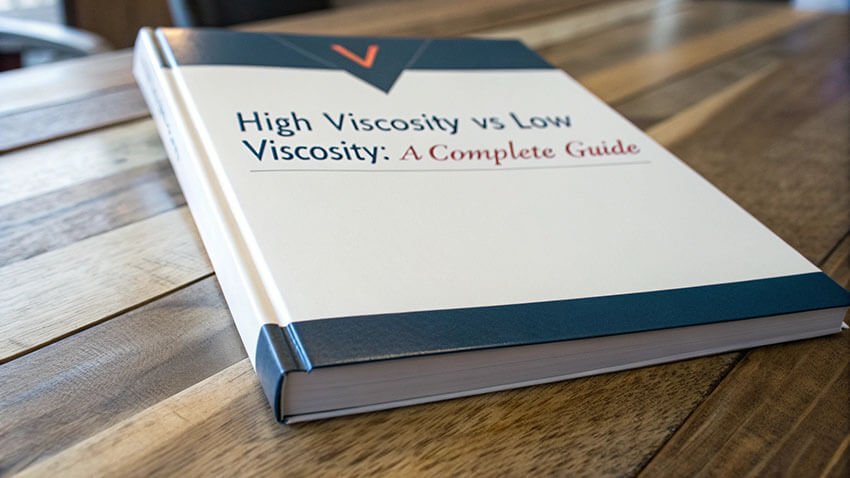Your product is too thick to pump or too thin to use, causing production delays and customer complaints. This unpredictability hurts your bottom line and damages your brand's reputation.
High viscosity fluids, like honey, are "thick" and resist flow. Low viscosity fluids, like water, are "thin" and flow easily. Understanding this key difference is the first step to controlling your product's quality, performance, and manufacturing efficiency.
As the owner of Martests, a viscometer factory, I speak with purchasing managers every day. They face real-world challenges where fluid behavior directly impacts their success. They don't need complicated academic theories; they need practical solutions. This guide is built on my experience helping clients, from large distributors to specialized labs, master their materials. Let's break down this fundamental concept.
A Practical Look at High vs. Low Viscosity?
Getting viscosity wrong is frustrating. It leads to inconsistent products that customers reject. This practical guide simplifies the concept so you can finally gain control over your fluids.
High viscosity means a fluid is "thick" and resists flow, like syrup. Low viscosity means it's "thin" and flows easily, like water. The key is measuring this resistance to control your product's behavior and performance, ensuring consistency.
In simple terms, viscosity is a fluid's internal friction. Imagine trying to run through a pool. Running through water is relatively easy (low viscosity). Running through a pool of mud would be very difficult (high viscosity). The mud resists your movement more than the water does. This resistance is exactly what we measure. We usually express this value in units called centipoise (cP) or millipascal-seconds (mPa·s), which are identical. For reference, water is about 1 cP, while honey can be over 2,000 cP.
This internal friction comes from the forces between the molecules in the fluid.
- Low Viscosity: Fluids with weak intermolecular forces have molecules that slide past each other easily.
- High Viscosity: Fluids with strong intermolecular forces have molecules that cling together, creating more resistance.
Temperature is also a critical factor. Generally, when you heat a fluid, its viscosity decreases. This is vital in manufacturing. For example, a chocolate factory must keep its liquid chocolate at a precise temperature. If it's too cool, its viscosity increases, and it won't flow through the pipes. If it's too hot, its viscosity drops too much, affecting the final product's texture.
What are some everyday examples of high vs. low viscosity?
The terms "high" and "low" viscosity can seem abstract. This makes it hard to relate them to your own products. Seeing real-world examples makes the concept easy to understand.
High viscosity examples include honey, ketchup, and motor oil. They pour slowly. Low viscosity examples are water, milk, and gasoline. They flow quickly. Understanding these helps you categorize and control your own fluids for better product outcomes.

Seeing viscosity in action around us helps connect the scientific concept to real-world applications. The same principles that govern how ketchup flows from a bottle apply to industrial chemicals, cosmetics, and foods.
High Viscosity Examples in Daily Life
- Honey: Pours very slowly from a jar. Its high viscosity is a key quality marker and gives it the thick texture customers expect.
- Toothpaste: It needs high viscosity to stay on the toothbrush. However, it also needs to flow when you squeeze the tube. This shear-thinning behavior is a core concept in rheology.
- Motor Oil: This is a fantastic example of engineered viscosity. It must be viscous enough to coat and protect engine parts at high operating temperatures but thin enough to flow easily when the engine is cold.
Low Viscosity Examples in Daily Life
- Water: This is our baseline reference. It flows freely and quickly.
- Milk: Pours easily from a carton. Its low viscosity is essential for drinkability and for processing steps like homogenization and pasteurization.
- Solvents (like rubbing alcohol): These have very low viscosity. They spread quickly and evaporate fast, which is essential for their function as cleaning agents.
How does viscosity affect applications in the field?
Choosing the wrong viscosity can lead to catastrophic product failures. A paint that drips off the wall or a cream that feels watery is a disaster. Understanding application needs is vital.
In applications, high viscosity provides control, like a thick adhesive that stays in place. Low viscosity allows for easy flow, like ink in a printer. Matching the viscosity to the application is essential for performance and prevents costly failures.

For my customer Jacky in Italy, who resells paints under his own brand, viscosity is everything. The wrong viscosity means his customers will reject the product. Let's look at why it's so important across different industries.
High Viscosity Applications (Where Control is Key)
Adhesives, sealants, and cosmetic creams are great examples. An adhesive must be thick enough to fill a gap and hold components together without running out before it cures. A face cream needs high viscosity to feel rich and luxurious and to stay on the skin after application. Paint is another key area. It must be viscous enough at rest (low shear) to not drip from the brush or wall, but it must thin out (shear-thinning) when brushed or sprayed for smooth application.
Low Viscosity Applications (Where Flow is Essential)
Think about anything that needs to be sprayed, pumped quickly, or injected. The ink in an inkjet printer must have a very low, precisely controlled viscosity to pass through tiny nozzles without clogging. In the food industry, beverages like juice and soda need low viscosity for efficient pumping, bottle filling, and, of course, a pleasant drinking experience. Similarly, pharmaceutical liquids for injection must have a low viscosity to be easily and painlessly administered with a syringe.
The Financial Impact of Poor Viscosity Control
Getting viscosity wrong is expensive. It leads to wasted batches, product recalls, and customer dissatisfaction. A batch of sauce that is too thin might have to be re-cooked with more thickeners, costing time, energy, and materials. Or worse, it might be thrown away entirely. A lubricant that is too thick could cause machinery to fail, leading to costly downtime and repairs.
How can Martests help you gain control of your fluids?
You know viscosity is important, but you don't know where to start. Choosing the right instrument feels overwhelming. We can simplify this process for you and provide a reliable solution.
Martests provides high-quality rotational viscometers that give you accurate, repeatable measurements. We help you choose the right model and spindle for your specific fluid, whether it's high or low viscosity, ensuring you get the control you need.

My name is Stefan Wang, and at Martests, we are a factory that manufactures these instruments. We are not just traders. This means we have deep knowledge of the technology and can ensure top quality. We help clients like purchasing managers and distributors every day. They need reliable tools that provide accurate data without being overly complex.
Need the Right Viscosity Measurement?
We guide our clients to the perfect solution. For a customer measuring thin oils or solvents, our LV (Low Viscosity) series viscometers are the ideal choice. For another client working with thick pastes or gels, our HV (High Viscosity) series provides the necessary torque. For specialized needs, we offer instruments like Cone and Plate viscometers, which are perfect for small sample volumes and absolute viscosity, or Krebs Stormer viscometers, the industry standard for paints. Because we are a factory, we can also offer customization. For distributor clients like Jacky, we apply their company logo directly onto the viscometers, allowing them to build their own brand in their local market.
What are some frequently asked questions?
You still have specific questions about how viscosity affects your business. Getting clear, simple answers is difficult. We've compiled the most common questions our clients ask.
This FAQ answers key business questions about viscosity, like what 'high' or 'low' means for your process, how fluids are measured, and how to select the right viscometer for your specific product, providing quick, practical guidance.

Here are the answers to the questions I hear most often from purchasing managers and company owners.
1. What does high viscosity mean in business terms?
In business, high viscosity often means higher processing costs. You may need more powerful pumps and mixers, which consume more energy. Mixing times can be longer, potentially slowing down production. On the other hand, for the final product, high viscosity can signify quality. A thick lotion feels richer, a thick sauce seems more premium, and a thick coating provides better protection. It can be a key feature that allows you to command a higher price.
2. And what is the low viscosity meaning for my process?
Low viscosity generally means lower processing costs. Fluids are easier to pump, mix, and fill into containers, which can speed up your production line. However, it can also present challenges like splashing during high-speed filling. For the end product, low viscosity can sometimes be perceived as "watered down" or lower quality if a customer expects a thicker consistency.
3. Are all fluids measured the same way?
No. The instrument and setup must match the fluid. A thin fluid like a solvent (low viscosity) is best measured with an LV series viscometer using a large spindle to get a measurable torque reading. A thick paste (high viscosity) requires an HV series viscometer with a small spindle. Using the wrong combination will give you inaccurate or unusable data.
4. What are some other high viscosity vs low viscosity examples?
To give you a broader idea:
- High Viscosity: Asphalt, molasses, silicone caulk, hair gel.
- Low Viscosity: Vinegar, gasoline, liquid soap, cleaning solvents.
5. How do I choose the correct viscometer?
First, estimate your fluid's viscosity range (low, medium, or high). Second, consider your application: is it for quick quality checks on the production line or for more detailed product development? Third, contact us. Send an email to me, Stefan Wang, at info@martests.com. We can discuss your specific product and budget and guide you to the correct viscometer model (LV, RV, or HV) and accessories to get the job done right.
Conclusion
Understanding high vs. low viscosity is the first step. Measuring it correctly with the right instrument from Martests gives you control over your product quality and your bottom line.


